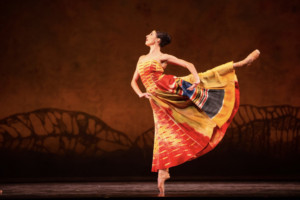Review: Exuberant LAMBARENA Blends African & Classical Dance at the Milwaukee Ballet

When the Milwaukee Ballet presents a trio of works in one mixed program, odds are something will resonate - if not the haunting music of one piece, then the vibrant rush of costumes in another. Aesthetics aside, one can always appreciate the power and poise of the Milwaukee Ballet Company dancers and the skill and grace with which they execute such a range of choreography. This weekend's selections feature world premieres by choreographers Enrico Morelli and George Williamson, plus the much-buzzed-about Lambarena, choreographed by Val Caniparoli.
The evening works its way from Morelli's moody Compieta to the exuberant Lambarena - a nice progression that leaves audiences on a high note. Morelli's dreamlike sequence features a cast of sixteen. "There is no narrative to this piece," says Morelli. "No linear timeline. There is a universe of memories; of future intentions, of fears, of dreams or nightmares, constantly ruined by reality." Morelli achieves an evocative, anxious, surreal experience. Movements are ever-entwined and fluid with an intentional push and pull. Morelli also designed the costumes in shades of dark green, rust, black, and grey; a solemn yet pleasing palette made more intriguing by the use of sheer fabrics and, sometimes, skirted men.
Williamson's Albatross may be a surprise favorite. The 10 dancers featured each don simple white bodysuits to become a veritable flock of albatross. Per the choreographer's note: "This piece evokes the passing of seasons, which is in itself a metaphor for the milestones we reach between life and death. The title references the albatross, a bird which mates for life." The choreography tells of a pair of birds, their love, their offspring, and that offspring leaving the nest. The depth of this pair's bond, the weight of their love and the life they've built - it all comes through in exquisite choreography and dancing. Albatross is beautiful, moving, and incredibly mesmerizing.
For the finale comes Caniparoli's high-spirited Lambarena, blending traditional African rhythms and dance with compositions by Johann Sebastian Bach and classical ballet. "I wanted to show that you can do either kind of movement to both kinds of music," Caniparoli says. This juxtaposition is a singular experience and a true joy to watch. If anything, the breaks between songs are more jarring than the mix of African and classical; there really isn't a story here, rather a study of music and movement. Costumes by Sandra Woodall are stunning, especially the gorgeous sweep of brightly-dyed skirts, whose movement is a dance all its own.
What the Milwaukee Ballet excels at is making room for different styles of dance. There's always space for fully-classical pieces (A Midsummer Night's Dream will be on stage this May), but dance is so much more than tutus. In showcasing contemporary choreographers alongside the classics, the Milwaukee Ballet taps into trends that speak to the evolution of dance and grow a more diverse audience. The pieces in this Lambarena mixed program sum up the overarching goals of Artistic Director Michael Pink and the Milwaukee Ballet: to commit to the future of dance through new work, education, and collaboration.Photo credit: Mark Frohna
Reader Reviews
Videos

